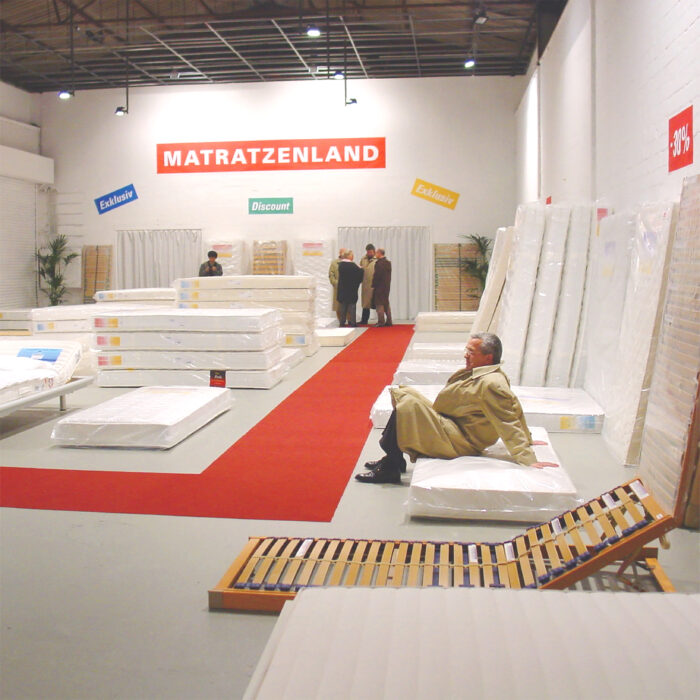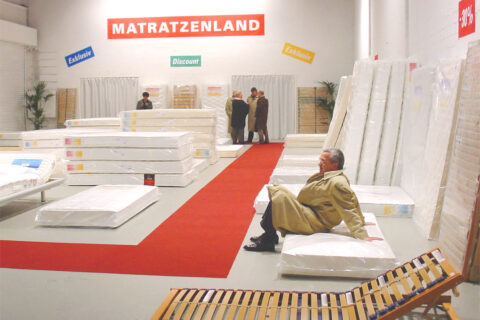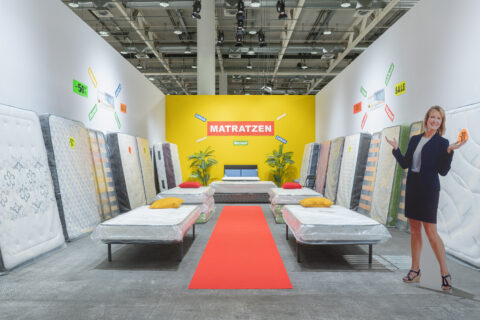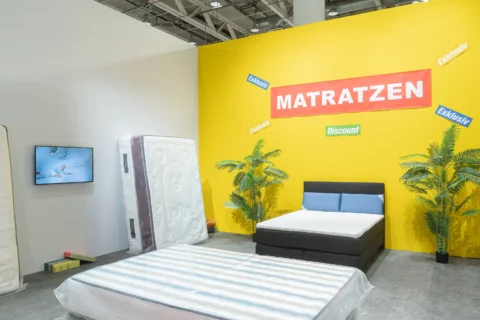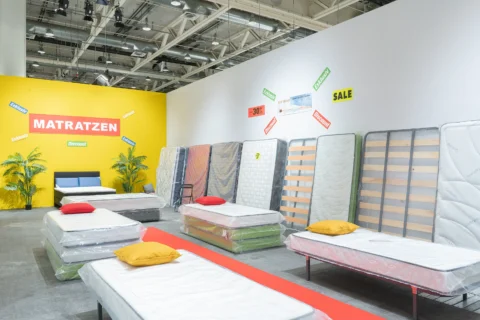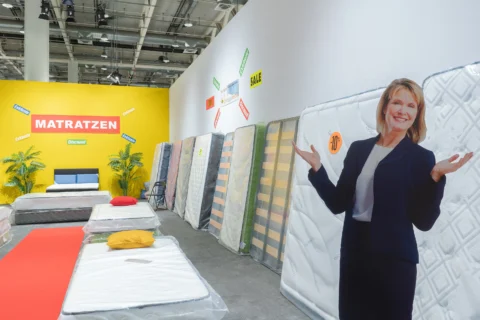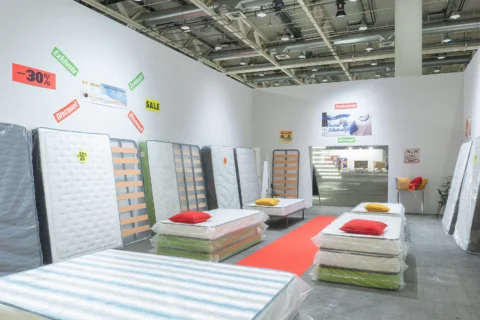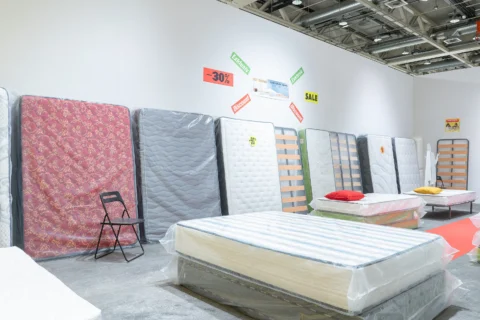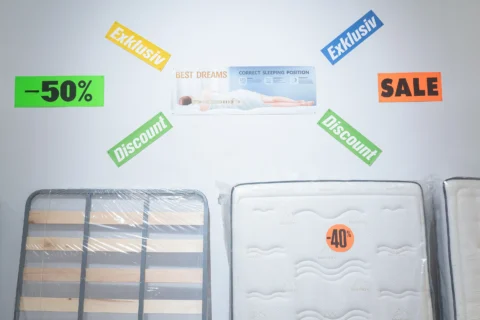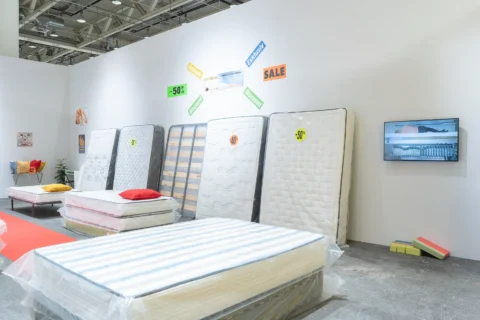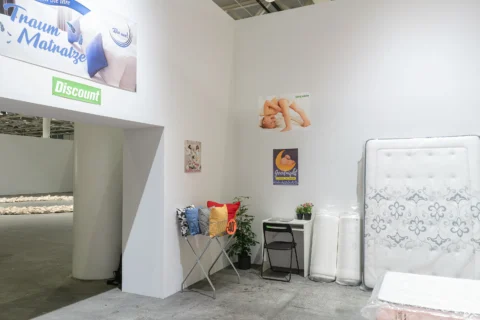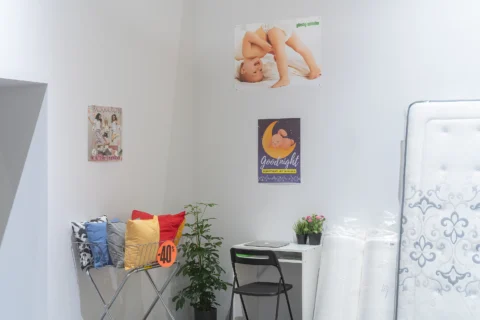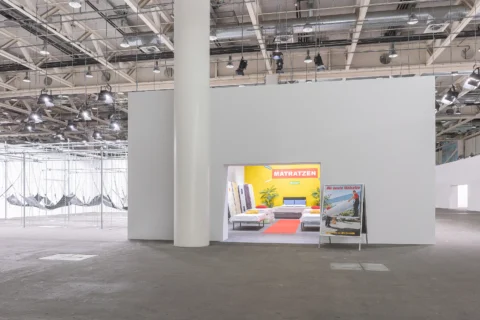Guillaume Bijl Matratzentraum
12/06/2023 – 18/06/2023
Hall 1 | Booth U 23
Messe Basel
Messeplatz 10
4058 Basel, Switzerland
Art Basel Website / Nagel Draxler @ Art Basel
Unlimited Opening (by invitation only)
Monday, June 12: 4pm to 8pm, First Choice VIP cardholders
Monday, June 12: 6pm to 8pm, Preview VIP cardholders
VIP Days (by invitation only)
Tuesday, June 13: 11am to 8pm, First Choice VIP cardholders
Tuesday, June 13: 4pm to 8pm, Preview VIP cardholders
Wednesday, June 14: 11am to 8pm
Vernissage (by invitation only)
Wednesday, June 14: 5pm to 8pm
Public Days
Thursday, June 15: 11am to 7pm
Friday, June 16: 11am to 7pm
Saturday, June 17: 11am to 7pm
Sunday, June 18: 11am to 7pm
Special Nights
Unlimited Night: Thursday, June 15: 7pm to 10pm
Press Release
At Art Basel Unlimited Galerie Nagel Draxler and Meredith Rosen Gallery present Guillaume Bijl’s installation „Matratzentraum“, originally shown at Ausstellungshalle Hawerkamp, Münster in 2003 and later shown at Cultuurcentrum Mechelen, 2016, and at ADN Platform, Barcelona, 2017. Since 1979, Bijl has contended with the status of exhibition space through his Transformation-Installations by meticulously reconstructing art spaces into a Casino (1984), a Secondhand Car dealership (1984), a Fitness Center (1985), a Shooting Gallery (1985), a Wig Shop (2012), a Thai Massage (2022) among others. In 1984, the artist staged a Lamp Stand at Art Basel. Klaus Littmann presented Bijl’s "Neuer Supermarkt" at his gallery in Basel in 1990 wherein the artist reconstructed a grocery store in the exhibition space. Over the past year, Bijl has received increasing critical reception reignited through his work with Meredith Rosen Gallery, most recently "Casino" at Art Basel Miami Beach, 2022.
Bijl’s chosen form of installation is built on the premise of a fictional narrative wherein the art space is no longer of use to the public and is rented out to a more functional business, i.e. a travel agency, supermarket, driving school, or a hair salon. When the art venue is transformed into a mattress store, the element of fiction is immediately present. Upon expecting a typical gallery setting, viewers were immersed in a hyper realistic store environment, like what one might encounter in a strip mall. Bijl’s archaeology in real time reveals the practices, behavior, and values of the present. Because this environment is situated in an art space, it is appreciated as sculpture. Through this displacement, he commodifies our behavior and creates a lens through which we observe ourselves within culture. The mattress, as a site, evokes the banal space of rest, routine, and the basic need for shelter.
Each Transformation-Installation is site specific, considering the architecture of the space and context of the location. The precision of Bijl’s practice places the viewer in a disorienting scenario wherein objects hover between the illusion of their associated setting and their situation as art objects. His Transformation- Installations have dealt with subjects as wide ranging as church, education, army, travel, careerism, sex, psychiatry, mass consumption and the rut of blue-collar existence.
For the restaging of "Matratzenland-Installation" (Mattress Store Installation) at Art Basel Unlimited, Bijl will transform the exhibition space into an exact stereotype of a mattress store as was executed from his earlier presentations. Each detail is scrupulously considered by the artist down to the price tags, cellophane wrapped mattresses, bed model, signage, and fluorescent lighting. Mattress stores, with their connotation of domesticity, rest and home, correlate to current events in Europe juxtaposed with the integrity of connoisseurship and object value at Art Basel. The mundanity of a mattress store evokes a deeper investigation into the commodification of home and rest. Furthermore, the dichotomy of being asleep or awake is presented as a psychological shift between lockdown and the aftermath. These fundamental values of human life are stripped from their intrinsic nature and sold as an appliance. Bijl’s placement of the consumption of home within the locus of an art fair, sheds light on the capitalist nature of value ascription to basic human needs and symbolic beliefs via art. Originally shown in 2003, the restaging of Bijl’s significant contribution to installation art 20 years later emphasizes the lasting impact of this work.
Current press (selection):
ArtIBasel
artnet
Numéro
